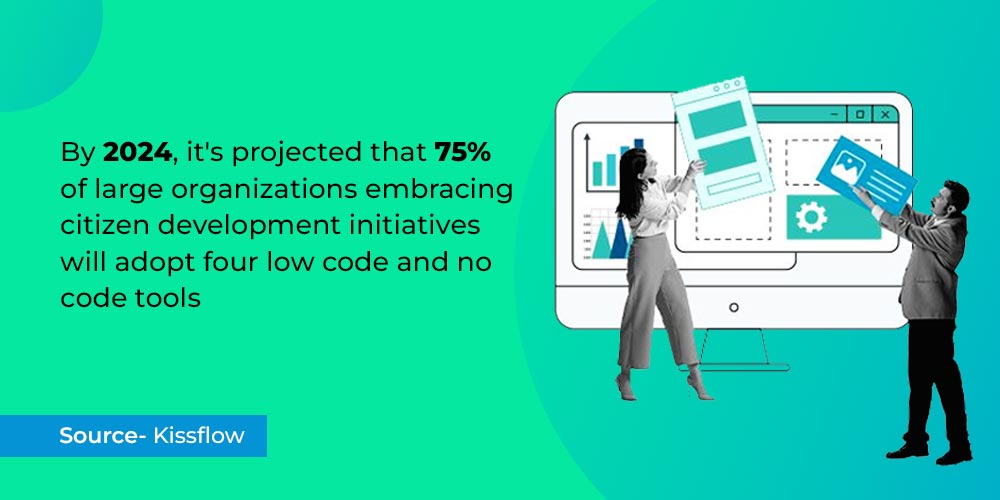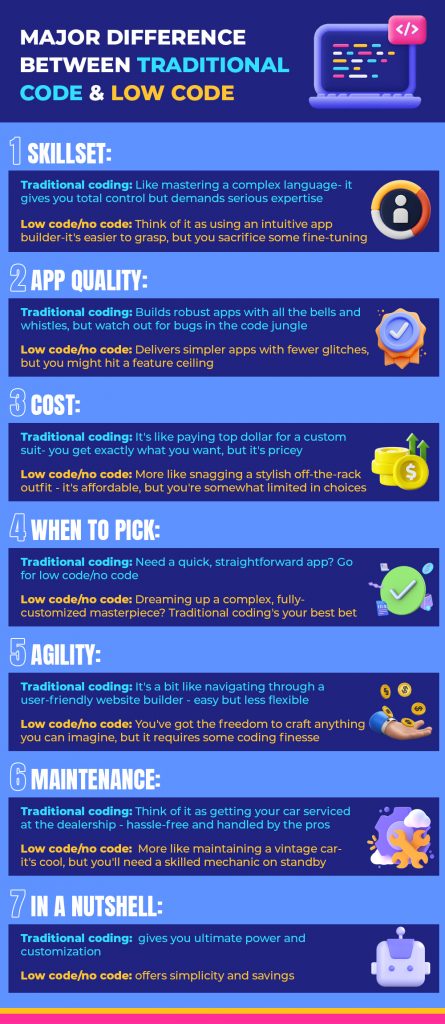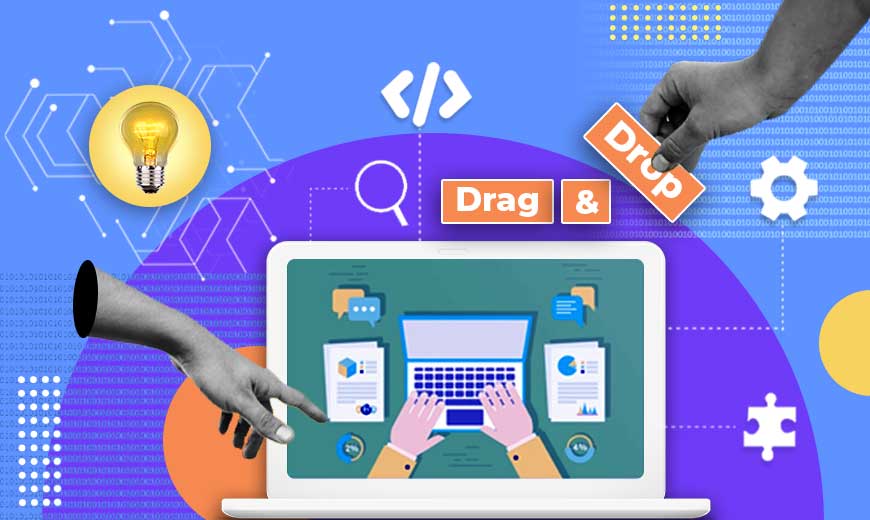The Future of Low Code Vs No Code
In today’s rapidly evolving business landscape, the ability to adapt quickly and efficiently is paramount. This is where low-code and no-code development platforms are poised to make a significant impact. The future of low code and code is intertwined with rapid innovation and digital transformation.
According to Gartner, the market for low-code and no-code technologies is projected to reach a staggering $26.9 Billion, reflecting the growing demand for agile and user-friendly solutions in software development. Let’s delve deeper into the future of these transformative approaches and explore how they are reshaping the software development landscape.


Understanding Low Code and No Code
Before we delve into the prospects, let’s understand the core concepts of low code and no code.
Low Code: Low-code development involves minimal manual coding, leveraging visual interfaces and pre-built components to accelerate the software development process. It aims to simplify development tasks and make them accessible to a wider audience, including individuals without extensive coding experience.
No Code: On the other hand, no-code development takes simplicity to the next level by enabling users to build applications without writing a single line of code. Through intuitive drag-and-drop tools and web-based forms, non-programmers can design and deploy functional applications, democratizing the development process and empowering business users. AI-driven automation is shaping the future of low code and code development.
The Growth Trajectory: Why Low Code and No Code Are the Future
Faster Development, Lower Costs:
One of the primary drivers behind the adoption of low-code and no-code platforms is their ability to expedite the development process while reducing costs. By eliminating the need for extensive manual coding, these platforms enable rapid prototyping and iteration, resulting in faster time-to-market and lower development costs. The future of low code and code promises unprecedented speed and efficiency in software creation.
Improved Agility and Collaboration:
In today’s competitive landscape, agility and collaboration are key to staying ahead of the curve. Low-code and no-code platforms facilitate collaboration between technical and non-technical stakeholders, enabling real-time feedback and iteration. This promotes agility and ensures that applications meet the evolving needs of users and market trends. Containerization and edge computing are paving the way for the future of low code and code.
Specific Use Cases:
Low-code and no-code platforms find applications across various domains, including website creation, app development, and workflow automation. Whether it’s building a simple website or developing a complex business application, these platforms offer flexibility and scalability to cater to diverse use cases. Enhanced collaboration and integration are at the forefront of the future of low code and code platforms.
Addressing Concerns:
Despite their numerous benefits, low-code and no-code development platforms also raise concerns, such as security and vendor lock-in. However, these concerns can be mitigated through robust security measures and careful vendor selection. By prioritizing security and compliance, businesses can leverage the full potential of these platforms while minimizing risks. The future of low code and code platforms is characterized by democratized development and increased accessibility.
Read more about Low Code Vs No Code
The Rise of Citizen Developers: Empowering Innovation
One of the most remarkable aspects of the low-code/no-code revolution is the emergence of citizen developers. These are individuals who, despite lacking formal programming backgrounds, leverage low-code/no-code platforms to build applications tailored to their unique needs. By empowering citizen developers, organizations can tap into a broader pool of talent and foster a culture of innovation and experimentation. Blockchain integration holds immense potential for the future of low-code and code applications.
Mitigating Risks: Security and Compliance
While the benefits of low-code/no-code development are undeniable, it’s essential to address potential risks, particularly in terms of security and compliance. The ease of use and rapid deployment offered by these platforms can inadvertently expose organizations to security vulnerabilities if not adequately managed. Implementing robust security measures and adhering to industry best practices is critical to safeguarding sensitive data and ensuring regulatory compliance. With a focus on security and scalability, the future of low code and code platforms ensures robust and reliable solutions.
Looking Ahead: Future Trends and Innovations
As we look to the future, several trends and innovations are poised to shape the evolution of low-code/no-code development. Advances in artificial intelligence and machine learning are expected to further automate and streamline the development process, enabling even greater levels of productivity and efficiency. Additionally, the integration of low-code/no-code platforms with emerging technologies such as blockchain and the Internet of Things (IoT) holds the promise of unlocking new possibilities for innovation and disruption across industries. The convergence of IoT and low code and code heralds a new era of interconnected applications.
The Rise of Citizen Developers: Empowering Innovation
One of the most remarkable aspects of the low-code/no-code revolution is the emergence of citizen developers. These are individuals who, despite lacking formal programming backgrounds, leverage low-code/no-code platforms to build applications tailored to their unique needs. By empowering citizen developers, organizations can tap into a broader pool of talent and foster a culture of innovation and experimentation. This democratization of software development not only accelerates the delivery of applications but also promotes a culture of innovation within organizations, where employees are encouraged to explore and implement their ideas.
Mitigating Risks: Security and Compliance
While the benefits of low-code/no-code development are undeniable, it’s essential to address potential risks, particularly in terms of security and compliance. The ease of use and rapid deployment offered by these platforms can inadvertently expose organizations to security vulnerabilities if not adequately managed. Implementing robust security measures and adhering to industry best practices is critical to safeguarding sensitive data and ensuring regulatory compliance. Additionally, organizations must prioritize ongoing training and education to ensure that developers and users understand the importance of security and compliance in the development process.
Looking Ahead: Future Trends and Innovations
As we look to the future, several trends and innovations are poised to shape the evolution of low-code/no-code development. Advances in artificial intelligence and machine learning are expected to further automate and streamline the development process, enabling even greater levels of productivity and efficiency.
The integration of low-code/no-code platforms with emerging technologies such as blockchain and the Internet of Things (IoT) holds the promise of unlocking new possibilities for innovation and disruption across industries. Furthermore, the rise of edge computing and serverless architectures presents new opportunities for deploying low-code/no-code applications in distributed environments, enabling organizations to build and scale applications more efficiently.


Conclusion
In conclusion, the future of software development is being reshaped by the rapid proliferation of low-code and no-code technologies. These platforms offer a compelling solution to the growing demands for agility, efficiency, and innovation in today’s digital landscape.
By embracing the potential of low code and no code, organizations can accelerate their digital transformation journey, unlock new growth opportunities, and maintain a competitive edge in an ever-evolving market. As industries embrace digitalization, the future of low code and code offers limitless possibilities for innovation and growth.
As we navigate the complexities of the digital age, the importance of staying abreast of emerging trends and technologies cannot be overstated. By leveraging the insights and capabilities offered by low-code and no-code development platforms, organizations can position themselves for success in the dynamic and rapidly evolving landscape of software development.







